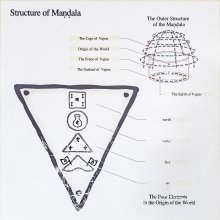Vajramala, Vajramālā: 7 definitions
Introduction:
Vajramala means something in Buddhism, Pali, Hinduism, Sanskrit, Marathi. If you want to know the exact meaning, history, etymology or English translation of this term then check out the descriptions on this page. Add your comment or reference to a book if you want to contribute to this summary article.
Images (photo gallery)
In Buddhism
Tibetan Buddhism (Vajrayana or tantric Buddhism)
Source: Wisdom Library: MañjuśrīnāmasaṃgītiVajramālā (वज्रमाला) is one of the eight offering goddesses appearing in the Vajradhātu-mahāmaṇḍala, according to the Nāmamantrārthāvalokinī v5.36-37. The Nāmamantrārthāvalokinī (literally, ‘an explanation of the nāma-mantras’) is a commentary (ṭīkā) on the 8th century Mañjuśrīnāmasaṃgīti.
Vajramālā is a name of Mañjuśrī (the embodiement of non-dual knowledge) and, together with other names, forms the core essence of the Mañjuśrīnāmasaṃgīti. The Nāmamantrārthāvalokinī provides the practitioner a sādhana (‘meditative practice’) to turn these names into mantras. These mantras are chanted for the benefit of all beings, and then placed and contemplated in the Vajradhātu-mahāmaṇḍala, which is an extended version of the Vajradhātu-maṇḍala.
Source: Google Books: An Illustrated History of the MandalaVajramālā (वज्रमाला) is the name of the “Rishu-e” associated with the Hāsyā and Rati (“looking”): one of the Seventeen Viśuddhipadas (“stations of purity”), according to the Prajñāpāramitānayasūtra: an ancient Buddhist Tantric text recited daily in the Japanese Shingon sect which is closely related to the Sarvatathāgatatattvasaṃgraha.—The seventeen-deity maṇḍala, representing the deification of the seventeen viśuddhipadas, corresponds to the great maṇḍala described in the Mahāsamayatattvavajra, which explains seventeen viśuddhipadas (twenty in the Chinese translation).
Source: OSU Press: Cakrasamvara SamadhiVajramālā (वज्रमाला) refers to the “vajra-garland” [i.e., oṃ vajramāle trāṃ], according to the Guru Mandala Worship (maṇḍalārcana) ritual often performed in combination with the Cakrasaṃvara Samādhi, which refers to the primary pūjā and sādhanā practice of Newah Mahāyāna-Vajrayāna Buddhists in Nepal.
Source: MDPI Books: The Ocean of HeroesVajramālā (वज्रमाला) refers to a “string of vajras”, according to the 10th-century Ḍākārṇava-tantra: one of the last Tibetan Tantric scriptures belonging to the Buddhist Saṃvara tradition consisting of 51 chapters.—Accordingly, [while describing the Adamantine Circle (vajracakra)]: “ [Every] Yoginī on all [twelve] circles—she [has] four arms, [has] one face, holds a skull bowl and a skull staff [in the two left hands], also [holds] a small drum and a knife [in the two right hands], [has her] hair untied, is naked, [has her] body [ornamented with] the five seals, is adorned with a string of Vajras (vajramālā), stands on a corpse, and is very terrifying; [she] wears various [good] ornaments and is a wisdom accompanying a means (her male consort). [...]”.

Tibetan Buddhism includes schools such as Nyingma, Kadampa, Kagyu and Gelug. Their primary canon of literature is divided in two broad categories: The Kangyur, which consists of Buddha’s words, and the Tengyur, which includes commentaries from various sources. Esotericism and tantra techniques (vajrayāna) are collected indepently.
Languages of India and abroad
Marathi-English dictionary
Source: DDSA: The Molesworth Marathi and English Dictionaryvajramālā (वज्रमाला).—f (S) A diamond-necklace.
Marathi is an Indo-European language having over 70 million native speakers people in (predominantly) Maharashtra India. Marathi, like many other Indo-Aryan languages, evolved from early forms of Prakrit, which itself is a subset of Sanskrit, one of the most ancient languages of the world.
Sanskrit dictionary
Source: Cologne Digital Sanskrit Dictionaries: Edgerton Buddhist Hybrid Sanskrit DictionaryVajramālā (वज्रमाला).—name of a ‘gandharva maid’: Kāraṇḍavvūha 4.16.
Source: Cologne Digital Sanskrit Dictionaries: Monier-Williams Sanskrit-English Dictionary1) Vajramālā (वज्रमाला):—[=vajra-mālā] [from vajra > vaj] f. a [particular] Samādhi, [Kāraṇḍa-vyūha]
2) [v.s. ...] Name of a Gandharva maiden, [ib.]
Sanskrit, also spelled संस्कृतम् (saṃskṛtam), is an ancient language of India commonly seen as the grandmother of the Indo-European language family (even English!). Closely allied with Prakrit and Pali, Sanskrit is more exhaustive in both grammar and terms and has the most extensive collection of literature in the world, greatly surpassing its sister-languages Greek and Latin.
See also (Relevant definitions)
Partial matches: Vajra, Maala, Mala.
Full-text: Hasya, Nikumbha, Vishuddhipada.
Relevant text
Search found 3 books and stories containing Vajramala, Vajramālā, Vajra-mala, Vajra-mālā; (plurals include: Vajramalas, Vajramālās, malas, mālās). You can also click to the full overview containing English textual excerpts. Below are direct links for the most relevant articles:
Blue Annals (deb-ther sngon-po) (by George N. Roerich)
Chapter 7 - Dharma Cycles originating from the great adept Mitra < [Book 14 - Great Compassion Cycle]
Chapter 25 - Rgwa lo < [Book 10 - The Kālacakra]
Chapter 16 - Shes rab rgyal mtshan < [Book 10 - The Kālacakra]
Puranic encyclopaedia (by Vettam Mani)
Tibet (Myth, Religion and History) (by Tsewang Gyalpo Arya)
8. The Three Yanas < [Chapter 7 - Buddhism in Tibet]
